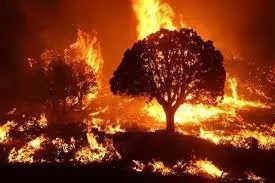Wildfires in US: Are Americans entering fire-prone areas? Check reasons behind rising incidents
Showing concern, author of the study Volker Radeloff said, “Fire risk has risen, but development patterns have not changed.”
In the past three decades, the unabated housing growth has exposed 47 per cent of homes to wildfires. Moreover, another 53 per cent have come into the expanded burned areas and 11.3 per cent homes which were within the fire perimeters were destroyed.
Meanwhile, authors from the University of Wisconsin in the study stated, “During the 1990s and 2000s, the WUI was the fastest-growing land cover type in the U.S.”
The study said that California and Texas have a large number of homes in WUI. while California has 5.1 million homes in a WUI Texas has 3.2 million homes.
During 2010 and 2022, more than 55,000 homes were destroyed by wildfires, resulting in tragic loss of life, economic loss and disruption to whole communities.According to the study, “Past wildfire areas had higher housing growth after wildfires than no-nfire areas. These numbers suggest that wildfire occurrence is not discouraging development. Even if another fire is unlikely in the immediate aftermath of a wildfire because of a lack of fuel, past wildfire areas can burn again within years or decades, depending on the vegetation type.”The study said that the type of vegetation surrounding your home matters. The proportion of vegetation types within 0.6 miles of a home was a “significant predictor of loss.”
Homes in evergreen and mixed forests were almost twice as likely to be destroyed in the event of a wildfire. Fires in the tops of trees in a forest are more intense and can disperse embers that ignite homes far from the fire front.
The study said that destruction caused by shrubland fires was much lower than forest fires but contribution of both was higher. The study added According to the study, 67% of areas burned in wildfires were in grass or scrublands. Only 33% of land burned by wildfires was in a forest.
According to the study, location also plays a role in wildfire incidents. Nearly 70% of homes destroyed in wildfires were in the West and more than 80 per cent in the east were destroyed in a wildfire were in a forest.
FAQs
Q1. What is wildland-urban interface (WUI)?
A1. WUI are zones where homes and vegetation are in proximity. These zones are at greater risk during situations like wildfire. Encroachment into these areas have been due to rise in population.
Q2. How are the reasons for wildfires?
A2. Wildfires are fires that mostly occur in places where the vegetation is of combustible nature. These can ignite naturally or by human activity.
Disclaimer Statement: This content is authored by a 3rd party. The views expressed here are that of the respective authors/ entities and do not represent the views of Economic Times (ET). ET does not guarantee, vouch for or endorse any of its contents nor is responsible for them in any manner whatsoever. Please take all steps necessary to ascertain that any information and content provided is correct, updated, and verified. ET hereby disclaims any and all warranties, express or implied, relating to the report and any content therein.
For all the latest world News Click Here


